| Two species share common names (Peanut-butter Fruit or Plant) and confusingly similar scientific names: Bunchosia argentea and Bunchosia Armeniaca. Therefore, I sought to learn what's the difference? Which is more commonly cultivated? This article shares my findings. The reason I care is because the plants bear pretty yellow blossoms and red edible fruit. |
| The English name Peanut-butter Plant is applied to at least four plant genera: Melianthus major (leaf scent); Clerodendrum trichotomum (leaf scent), Glyptopleura marginata (leaf flavor), and Bunchosia spp. (fruit flavor). It is only the latter that I write about here. |
| All 55 - 80 Bunchosia species are from tropical or subtropical Mexico, the West Indies, and South America. The generic name Bunchosia dates from 1822, when these plants were segregated from the 1753 genus Malpighia. The genus Malpighia and family MALPIGHIACEÆ commemorate Marcello Malpighi (1628 - 1694), distinguished Italian doctor and naturalist, who wrote on the anatomy of plants. George Don in 1831 explained: "Bunchosia, from Bunchos, the Arabic name for coffee, in allusion to the similarity between the seeds of this genus and those of coffee." |
From what I learned, of the few Bunchosia species that I studied, the one named (B. Armeniaca), has been cultivated sparingly, for fruit and ornament, in NW South America, and is, at certainly nominally, less cultivated and less known in the U.S. than another species (B. glandulifera --usually misidentified in U.S. horticulture as Bunchosia argentea). True Bunchosia argentea is fairly common in NW South America and is not cultivated there or elsewhere.
|
| Bunchosia Armeniaca (Cav.) DC. 1824 |
= Malpighia Armeniaca Cav. 1789
|
| Native in Bolivia, Brazil, Colombia, Ecuador, Peru, and Venezuela. A Kichwa (Quechuan language variant) name is Usan (Usuma, Ushum). Spanish names include: Ciruela verde, Ciruela silvestre, Ciruela de la tierra, Ciruela de cansaboca, Ciruela de fraile --translating Green Plum, Forest Plum or Monk's Plum; Indano. In English, we call it Peanut-Butter Fruit. |
| It is an evergreen shrub or tree 12 to 40 feet tall. The leaves are borne in opposite pairs, measure about 5 inches long, and are practically hairless. The largest leaves reach 8.25 by 4 inches. Flowers are small, yellow, in elongated clusters, giving rise to the fruits, about an inch long. The fruit's shape recalls the common apricot (Prunus Armeniaca), and hence the species was named in 1789 Malpighia Armeniaca, then Bunchosia Armeniaca in 1824. The seed or pit is said to be poisonous. |
| As for northern hemisphere cultivation, it was in Hawai'i by 1909. I found few books suggesting it is cultivated in the mainland U.S., mostly in Florida, to a minor extent. Tropical Flowering Plants by Kirsten Albrecht Llamas 2003, includes it. |
| Stephen Facciola, in Cornucopia II (1998) describes the fruit as very sweet, rather cloying pulp, eaten raw or in preserves. |
Richard J. Campbell in South American fruits deserving further attention (1996) wrote: "Precocious, fruiting within 3 years from seed. The trees flower and fruit throughout most of the year. Fruit are ellipsoid and borne in clusters. The red or yellow fruit are from 3 to 4 cm in length with a cream-colored flesh. The flavor is sweet, but often astringent. Even in areas where the tree is common, the fruit are not highly esteemed for fresh consumption. They are more commonly used as a flavoring. Bunchosia is a common addition to the home garden, but only rarely used as a commercial crop. The trees are tolerant of freezes, being slightly damaged by temperatures of -2 degrees C in Florida. Martin et al. (1977) finds it to have little potential for further commercialization. However, it could have potential, given its precocity and adaptive nature if superior cultivars could be identified."
|
At present, I know no mail-order nurseries offering this to U.S. customers. But possibly some plants sold as Bunchosia argentea are really it.
|
| Bunchosia argentea (Jacq.) DC. 1824 |
= Malpighia argentea Jacq. 1800-1809
|
| Native in Bolivia, Brazil, Colombia, Costa Rica, Ecuador, the Guianas, Panama, Peru, Venezuela. A Kichwa (Quechuan language variant) name is Wanpula panka. Spanish names include: Ciruela del monte --translating Mountain Plum; and Marmelo. In English, we call it Peanut-Butter Fruit. |
| George Don in 1831 wrote that its twigs were minutely hairy; leaves lance-shaped, glandular, and silvery beneath; and that it had been cultivated since 1810. The Latin name argentea means silvery. |
| The Flora of Suriname 1976, gives a technical description that I here paraphrase: Small tree [it can reach 65 feet tall] or shrub; young parts and flower clusters densely appressed-hairy; leaves densely silky on both sides, later hairless above; ovate or oblong; up to 16 by 9cm [6.25 by 3.5 inches]; 2(3) glands 1-2cm above the leaf base. Fruit silky. |
Clearly, this species, despite being listed in many books, catalogs and websites, is in fact never cultivated, and plants so-called are really either B. Armeniaca or B. glandulifera. It has hairy fruit. I suspected this, and it was confirmed by the expert botanist Dr. William R. Anderson, of University of Michigan's Herbarium; he is writing a monograph on the genus Bunchosia, and kindly supplied accurate corrections to my first draft of this article.
|
| Bunchosia glandulifera (Jacq.) Kunth 1822 |
= Malpighia glandulifera Jacq. 1790
|
| This species, compared to Bunchosia Armeniaca, is apparently more commonly cultivated in the United States (and certainly so in South America). It is not hard to find web sites and nurseries that discuss it under the name Bunchosia argentea and show photos of it. Perhaps native in northern Venezuela and Colombia, it is widely cultivated for its fruit elsewhere in northern South America. It has been called in French café moka and café bois, and in Spanish Ciruela. George Don in 1831 wrote that it had been cultivated in Europe since 1806. It is a shrub or small tree to 25 feet tall. The leaves are lightly hairy, and measure up to up to 18 by 12cm [7 by 4.75 inches], with wavy edges. The fruit can be an inch and an eighth in length. |
| The leaf hairs on the specimen that I purchased from Logee's Greenhouses of Connecticut, are very short, sparse, and tiny. The photos seen using Google's image search, show many plants that look like the one I bought. Again, the leaves of Bunchosia Armeniaca are hairless, while those of the real Bunchosia argentea are densely silky with hairs. |
| Assuming for the moment that the plants being sold and described and photographed under the name Bunchosia argentea appear to be misidentified specimens of Bunchosia glandulifera, below are examples of what is being written of them: |
| Cornucopia II (1998): Fruit about the size of a quail egg, reddish-orange, not very juicy, but with concentrated sugars much like a dried fig or American persimmon. |
| Logee's: "During the 1st year it should bloom several times March thru October. Once mature (8-10 inch pot), they will produce yellow flowers that turn into 1 inch fruits that ripen red. Fruits have soft, sweet, dense pulp and a large seed. The plants are naturally upright and for good fruit set, need warmth & sun. In the North, container-grown plants yield fruit by the fall --if in a greenhouse or conservatory with abundant heat, earlier. Zone 10 & higher outside. Grows 3-6 feet in container, min. temp. inside 40 degrees F." |
| Frankies nursery (HI): fast growing small tree. Attractive clusters of yellow flowers; abundant 1 inch fruits which turn red upon maturity. |
| FruitLovers.com (HI): "The fruits are orange when ripe and the size of a peanut. The tree likes full sun but can take some shade. Plant 12 feet apart. Good to pick when the fruits are just starting to turn orange but still hard. Let ripen fully indoors. Fully ripe when totally soft." |
| Daleysfruit.com.au: "Highly underestimated. Apart from being a valuable tree for the fruit it bears it is also highly ornamental. It can be grown into a bush or a small tree with a tendency to go deciduous during the winter. The yellow flowers are produced through late Spring and are followed by a nearly constant production of fruits in varying quantities. The dark-red to dark-orange fruit is the size of a quail egg and needs to be picked every day as they spoil quickly on the tree. They can be stored for several days in the refrigerator or can be separated from the seed and frozen. The skin is very tender with rich, sweet flesh that has a texture very similar to peanut butter or a sweet potato. The concentrated sugars of the fruit make it much like a dried fig. They are especially good when blended into a milkshake. The trees, which have a distant affinity to the Acerola Cherry, are hardy and highly tolerant of frost. They grow quickly and produce from their first year." |
The photos I show are on the specimen that I bought in September 2010 from Logee's Greenhouses. As you can see, in the 8+ months I have had it as a houseplant, it has grown larger. When it flowers I will take pictures. (In June 2012 it started.)
|
If by chance any readers have tasted the fruits of more than one of the three aforementioned species, and care to share opinions as to the relative merits, I welcome such news. If you desire a great deal more information on this genus, including photos, the definitive website is: (http://herbarium.lsa.umich.edu/malpigh/BunClade/Bunchosia/Bun1.html)
Back |
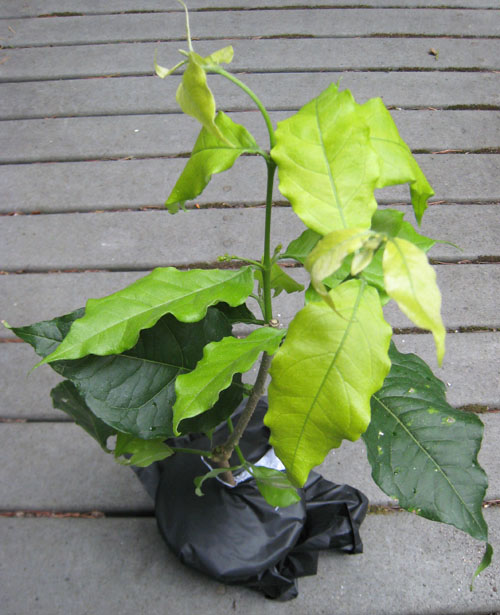
Bunchosia glandulifera miscalled B. argentea as bought from Logee's, September 15, 2010; photo by ALJ
|
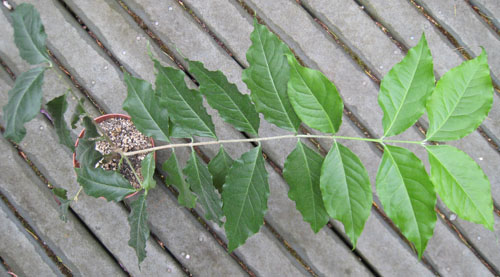
Bunchosia glandulifera miscalled B. argentea same plant 8 months later, May 30, 2011; photo by ALJ
|
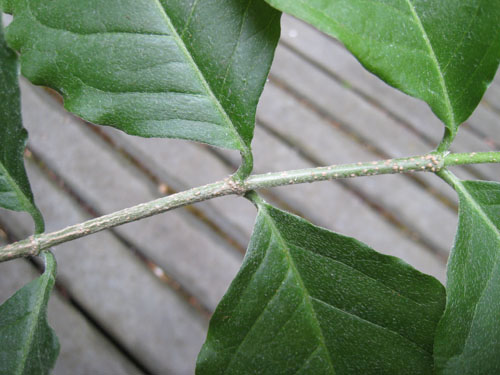
Bunchosia glandulifera miscalled B. argentea close up of stem and leaf hairs; photo by ALJ
|
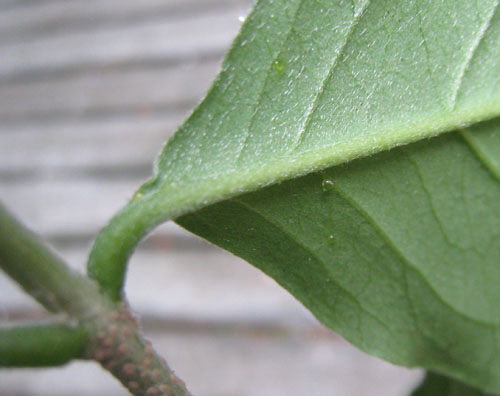
Bunchosia glandulifera miscalled B. argentea close up of glands on leaf underside; photo by ALJ
|
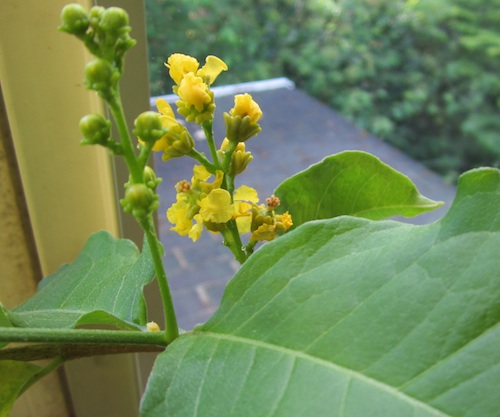
Bunchosia glandulifera miscalled B. argentea close up of flowers & buds; photo by ALJ
|

